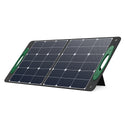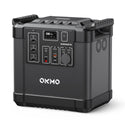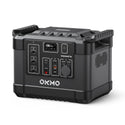Top 2 Best Portable Power Station Battery [Updated Jan.2022]
Posted by AdrianDrury on
(1) Everyone should have a portable power station
A device designed to provide 120 volt ac power for extended periods of time during power outages, remote power requirements, camping or emergency situations. Even set power for the entire router wifii during outages! But for van enthusiasts, a decent, high-quality portable power station is a must.
You can pre-charge through a wall outlet in your home, solar power or your car's alternator. The stored electricity is then used to operate ac electronics.
To be clear, these are not the noisy gas generators you see outside your campsite RV! These are silent! They're large battery units,
Portable power stations do not run on petrol or kerosene and do not produce annoying exhaust fumes. These can operate indoors and in enclosed Spaces without fear of carbon monoxide poisoning.
A portable power station is like carrying around a portable wall socket. Essentially, it's a high-capacity lithium-ion battery with enough power to actually run a 120V electronic device.
From camping, living in a van or RV, to spending weekends at the beach or on the course, the portable power station will keep your electronics alive and ready to use!
Top 2 choices for the best portable power station
The following is the list of the top 2 picks for best portable power stations:
(1) OKMO G1000 Portable Power Station 1000W, 300000mAh 1110Wh Backup Battery, 200W Max Input, PD 60W, Electric Solar Generator Outage Emergency Power Supply for Home Outdoors CPAP
These above are great for charging your battery operated electronics like phones, cameras and laptops,
these units also have the power to operate larger 120 VAC electronics like small refrigerators, projectors, lights, and etc…
Some common use cases for one of these portable power stations includes:
* Drone Operators – Bring a portable power station to recharge drone batteries and laptops.
* Photographers – Supplying power for a small business owner who needs to power things like laptops, cameras and lighting.
* VanLife – Living the nomad lifestyle, free as a bird! Using power for charging phones, laptops, small heaters, fans, TV’s and radios.
* Camping – Setting up an outdoor movie night in some remote location – powering a computer, projector and possibly a small refrigerator for keeping
beverages cool.
- * Remote Work – use the power station to power electric drills, skilsaw, etc…

- OKMO G1000 Portable Power Station 1000W, 300000mAh 1110Wh Backup Battery, 200W Max Input, PD 60W, Electric Solar Generator Outage Emergency Power Supply for Home Outdoors CPAP

- OKMO G2000 Portable Power Station 2000W, 600000mAh 2220Wh Lithium-ion Battery Backup Portable Generator, 200W Max Input, PD 60W, Solar Generator Outage Emergency Power Supply for Home Outdoors CPAP Camping RV
The Capacity of Portable Power Station
The more devices you have and the more power they consume, the faster you’ll run out of power. Therefore you’ll want a power station with a higher capacity.
Capacity is a measure of how much electrical output a portable power station can hold. This is usually measured in watt-hours.
Basically, the more watt-hours, the more power you can get out of your power station. Imagine you have a device that consumes 1 watt of power. On a power station with 100 watt-hours of capacity, that imaginary 1-watt device will run for 100 hours.
To figure out how much capacity you need, you’ll need to take a guess at how many devices you’ll have plugged in and how much power they draw. Most electrical devices have their power specs listed so look for the power consumption specifications on the devices you’ll be using.
Round up all your devices, find their power consumption listing, and then add them up.
If you’re recharging other batteries from your power station you can pretty easily add up the battery capacity for each battery you’re charging. Compare that to the size, in watt-hours, of your power station and you’ll know how many times you can charge a device with your power station.
Capacity and Maximum Power
The capacity represents how much energy the power station holds, and translates directly to how long it can power your electronics .
The max power represents the largest power draw the unit can handle.
The following are typical power draw values for some common household electronics.
Hair dryer: 800 – 1800W
Microwave: 600 – 1200W
Electric drill: 500 – 1000W
Blender: 500 – 750W
Mini-fridge: 50 – 500W
Laptop: 50 – 80W
Cell Phone Charger: 2 – 4W
Portable Power Station Battery Types
Most portable power stations today are going with lithium-ion batteries.
These batteries are more compact and lighter than the leading competitors.
That said, however, there is always something new in the world of battery technology.
Right now lithium batteries comprise the majority of the market and make the most sense in terms of cost and value.
How Portable Power Stations Work
Portable power stations work by taking energy from a source (input) such as power utilities, solar chargers, or other off-grid solutions and storing it in a big battery.
The size of this internal storage battery largely determines how suitable each power station is for given applications.
Once the portable power station is charged up, it’s ready to go.
Of course, the other side of the equation is output. Portable power stations need to be able to output that stored energy to a variety of devices. Output types may include 120V wall plugs, USB plugs, or cigarette lighter style plugs.
Remember that portable power stations have a limited amount of power to provide before they run out. Once that power is gone, you’ll have to recharge the portable power station.
To Charging a Portable Power Station
Portable power stations need to be charged up with energy before (or sometimes during) use. There are many options for doing so, but these are the most common:
Charge from utility power at home or using some type of outlet connected to utility power. Campground power pedestals, home wall outlets, extension cords in the garage… you get the idea. This is by far the fastest and most reliable source of charging power for your portable station.
Solar charge your portable power station in the field using solar panels. There are tons of manufacturers offering solar power solutions these days so get creative.
Most portable power stations store and use a lot of power, however, so small solar panels probably won’t cut it. You’ll need a solar panel with a good amount of output to keep up with even moderate consumption.
Hydro and wind chargers are uncommon and largely unreliable for most portable applications. However, if you have a permanent location such as a camp or homestead, there are some small hydro and wind turbine chargers out there that could make sense. Do your homework and be creative, you might be surprised.
Note: Many portable power stations can also be car charged. However, if your car isn’t running they’ll simply steal the power from your car’s battery. You’ll wind up with a dead car battery and no way to start the car! Be sure to charge your portable power station only when your car is running.
Solar panel Recommend
- Wide-Range Compatibility: The OKMO OS100 100W foldable solar panel can be connected to multiple adapters & is designed to work with most solar generators in the market, including any OKMO solar generator G1000 G2000 as well as generators from Rockpals Suaoki FlashFish & NexPow. With an adapter, it can also be used with other solar generators such as Baldr, Jackery, Goal Zero, and paxess

FAQs About Portable Power Stations
Q: What should I look for in a portable power station?A: Think for a while about what you want your portable power station to do. Many of the higher-end models cost a pretty penny and most are rated for 500 use cycles or more.
There’s a good chance this portable power station will be with you for many years, and outdoor seasons, to come. Buy within your budget and within reason, but don’t be afraid to upgrade a bit.
Right now you may only need to charge a laptop and a small tablet. What if you invite several friends along? Maybe you have kids growing up who will go camping or exploring with you. You may need more power down the road, and buying too small now will cripple you later.
Look for a power station that you can handle. Think about how you’ll transport it. Do you have a car with very little room? Maybe you have a huge long-bed F350 and space isn’t a problem.
Try to think down the road a little and consider the ways you will use your portable power station not only this year but in the future.
Q: How does a portable power station work?
A: Basically you charge a large battery with wall plugs, solar, car chargers, or any other source. That battery then becomes a portable power bank. These portable power batteries usually have many different types of outlets on them such as standard wall plugs, USBs, and vehicle accessory ports where you can plug-in devices.
A portable power station is, in essence, a large battery that powers your devices on the move. It’s like a massive portable phone charger, with tons of versatility.
Additionally, these big portable batteries usually have outdoor features like rugged durable casings, water-resistance, and other must-haves.
Q: How long do portable power stations last?
A: Since portable power stations revolve around their internal battery, this becomes a question of battery longevity.
Most portable power stations have a battery cycle rating. Many will cite specifications such as “80% after 400 cycles”. A cycle is generally measured by the number of times you empty and then recharge the battery.
So, in this instance, imagine you use your portable power station twice a month. A power station rated for 80% after 400 cycles would have 8 years of service before it wears down to 80% of its original health.
Of course, you can still use a power station with 80% of its original capacity so, in essence, this imaginary power station would really last many years longer.
Keep in mind, however, that battery health can also be majorly impacted by other factors.
Store your battery indoors at room temperature to avoid the degrading effects of cold weather on your battery. Also, when not in use always keep your portable power station battery topped-off on juice. Recharge after use and every few months in storage to avoid damage.
Q: How much power do I need?
A: This is a question two-fold.
First, you need to know the maximum draw of your biggest power-using device. See our section above about “peak power”. If you want to use an electric chainsaw you’ll need well over 1,000 watts of power. If you want to charge a phone you may need as little as 2-6 watts.
Second, how long do you want that power to last? You may get dozens or hundreds of charges out of a power station when charging a phone. Try to charge your car battery, however, and you may only get one or less! See our section on “portable power station capacity” for more on this.
OKMO Portal Power Station product meet your needs
Share this post
- 0 comments
- Tags: Most portable power stations today, Portable Power Station, Portable Power Stations For Sale





